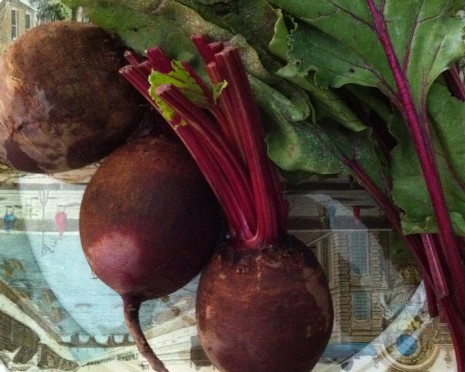OF BEETS AND BORSCHT
I am extremely fond of beets. What first drew me to them were their handsome, saturated pigments—their drama quotient is off the charts—but then their earthy, equally saturated sweetness took hold, and I was a goner.
Luckily, my husband, Sam, is of the same mind, and so we walk around with magenta-stained fingers all summer long. We eat beets every which way. Roasted, sliced, and tossed with thin raw onion rings, orange rounds, and a orange zest–spiked vinaigrette, they are wonderful with grilled fish, especially fresh sardines or bluefish. Pan-glazed with honey and balsamic vinegar, they turn a slice or two of cold sliced ham or pork roast into supper. Sliced and diced and served on pasta à la Laurie Colwin, they make an impromptu dinner party. And they’re reason alone to spring for a tin of walnut oil and a bunch of arugula or cress.
Beet tops, of course, are world-class pot greens—in fact, they sparked my inaugural blog post, almost two years ago. They become lush in flavor as well as texture without benefit of any help; seasoning meat seems superfluous, somehow, and they are my go-to cooking green when there are vegetarians in the house. The down side to beet greens is that they aren’t good keepers. If you can’t cook them the same day you buy them, separate the greens from the beets and store them separately; they will last another day or so, and the beets will stay juicier, too.
What I want to tell about now, though, is borscht, cold borscht. Generally speaking, I am not crazy about chilled soups, but given the sullen, sultry weather of late, borscht has been calling my name.
Naturally, Sam and his mother, Arlene, have had to get in on the act. They both thought my idea of using fresh beets instead of canned ones was quaint, but played along. “Put the beets in a pot and cover them with water,” they explained. “Cook them until they’re tender. Peel and grate the beets, then put them back in the liquid. Chill it and you’re done!”
I must have looked bewildered. “No matter what, you add garnishes,” Arlene said helpfully. “Chopped vegetables. You know, cucumber for crunch, and scallion, and radish—it’s peppery. Some people add boiled small potatoes and hard-boiled egg.” Sam interrupted. “But the most important thing is the sour cream,” he said. “That’s what gives the soup its body.”
“And tang,” Arlene elaborated, then adroitly upped the ante. “And why not use Greek yogurt instead? That would be good, too.”
I believed them. But that didn’t stop me from turning to The Jewish-American Kitchen, by Raymond Sokolov, with recipes by Susan Friedland. “In its simplest form, beet borscht is merely a cold soup made from beets and their cooking liquid,” I read.
It really is that easy.
Of course, it doesn’t have to be. I was intrigued by David Tanis’s homage to the cold borscht at Barney Greengrass, found in A Platter of Figs and Other Recipes. He cooks his beets in what is essentially a sweet-sour beet broth, and I think it was the citrusy coriander seeds, in particular, that spoke to me. In India, they’re considered a rejuvenating, cooling spice. Perfect, in other words, for borscht. At any rate, a sprinkle of freshly ground toasted seeds on top certainly plays well with all the other garnishes.
Cold Borscht chez Lear
Serves about 4
Adapted from Arlene Lear, Susan Friedland, and David Tanis
A dollop of sour cream looks beautiful on a bowl of borscht for about 30 seconds. Then it develops a lurid pink border, and the soup’s looks go downhill from there. If you like, do as David Tanis does and whisk the sour cream (or whole-milk yogurt, in his case) into the soup just before serving. Cold borscht makes a refreshing first course for dinner, but I’ve rapidly grown accustomed to it at lunchtime, with a slice of buttered brown bread.
About 2 pounds juicy summer beets (medium size), scrubbed and trimmed
Coarse salt
A little sugar (or not)
Fresh lemon juice, for spritzing
Optional garnishes
4 boiled small new potatoes, peeled, left whole
2 hard-boiled eggs, chopped
a few scallions, trimmed and chopped
A few radishes, trimmed and chopped
About ½ seedless cucumber, peeled and chopped
1 teaspoon or so coriander seeds, dry-toasted in a skillet until fragrant, cooled, then finely ground in a spice grinder or with a mortar and pestle
To finish
Plenty of sour cream or really good plain whole-milk yogurt
1. Cover the beets with a good 2 inches or so of water and season with salt. Bring to a boil, then lower heat and simmer, uncovered, until the beets are tender. Don’t be tempted to add more water, or you’ll dilute the ruby-red cooking liquid.
2. Remove the beets from the liquid. As soon as they’re cool enough to handle, peel and trim off any remaining gnarly bits of root and stem. Dice, grate, or julienne the beets. Pour the liquid into a bowl or pitcher, straining it first, if you like, then add the beets. Refrigerate until cold.
3. When ready to serve, add a spritz of lemon juice and a little sugar if you feel it’s warranted. Set out the garnishes and sour cream, so everyone can customize to his or her heart’s content.
Posted: August 15th, 2012 under cookbooks, people + places, recipes, summer.


